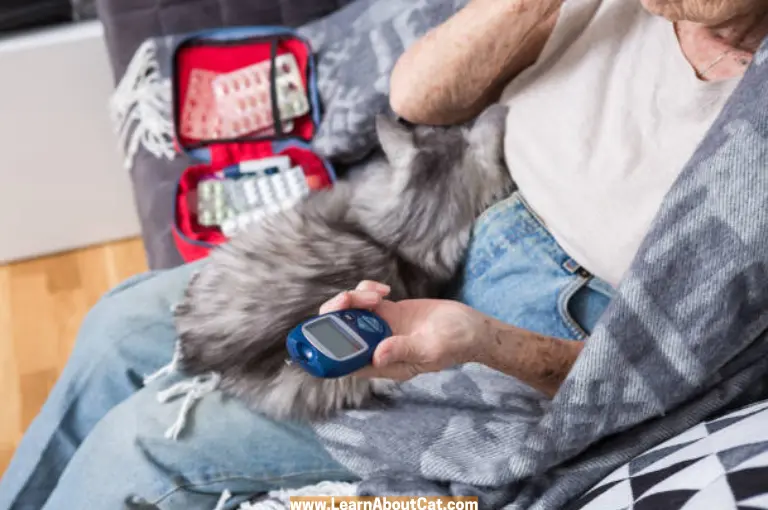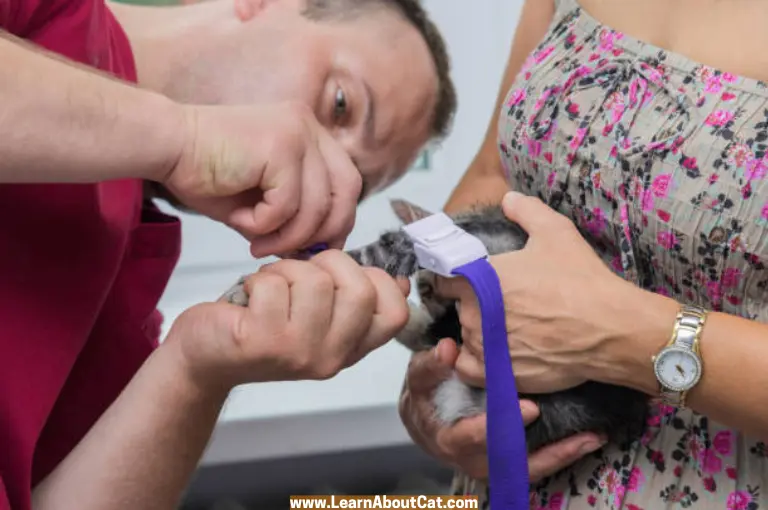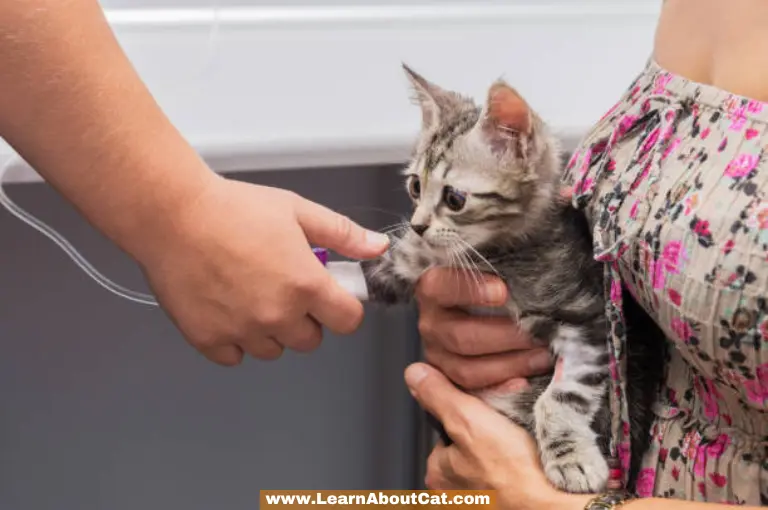Can I Use My Glucose Meter For My Cat?[Answered]
Since diabetes in cats may occur at any point in time, routine health exams are crucial for early identification. However, if you’ve got a busy schedule you might be thinking of checking your felines’ sugar levels with your glucometer. But does it give accurate results? Can I Use My Glucose Meter For My Cat This question may confuse you and you might be looking for an authentic answer. Here you go….
No, you can’t use your glucometer to check your cats’ blood glucose levels. The reason is that cats have different sugar levels as compared to us. Also, cats’ blood composition is different than ours. So, if you check their sugar level from your glucometer the result will be inaccurate which may cause problems for your cat in the future.
So, now you know why you can’t check your cats’ sugar level with your glucometer. But some of you might be curious to know what makes cats’ glucometers and diabetes different from ours. Don’t worry, in this informative article, you’ll find the answers to your every query regarding cats’ diabetes/sugar levels and how to check them at home. Let’s get into the details:

Can I Check My Cat’s Blood Sugar With My Glucometer? Can I Use My Glucose Meter For My Cat
Checking your feline’s sugar levels with your glucometer is usually not advised. Although the basic steps to determine glucose levels in people and cats are similar, there can be differences in the equipment’s sensitivity and calibration.
Cats’ blood chemistry and sugar levels can vary from those of humans. A human glucose meter may produce misleading findings, which might end up resulting in your cat’s condition being misdiagnosed or being given the wrong therapy.
If you think your feline is diabetic or has other medical problems involving glucose levels, it is recommended to visit a veterinarian. They can do an accurate blood sugar test and offer your cat the necessary advice and treatment alternatives.
Difference Between Human and Pet Glucose Meters?
Human and animal glucose meters differ significantly in several points. Some of the key variations are as follows:

- Calibration: Glucose meters for pets are designed for animals, like felines or dogs, whereas glucose meters for us are normally designed to test sugar levels in humans’ blood samples.
- Blood sample size: Human glucose meters are made for analyzing more blood samples, usually 0.6 to 1 microliters. However, as compared to human glucose meters, pet glucose meters are made to operate with small quantities, typically between 0.3-0.5 microliters.
- Algorithms: Pet glucose meters frequently utilize algorithms created expressly for cats or dogs. These algorithms provide more precise results for pets while taking into consideration the particular peculiarities of the pets’ blood chemistry and sugar levels.
- Testing area: The majority of humans monitor their sugar levels by puncturing their fingertips, as their glucometers are mainly designed for fingertip monitoring. While, pet glucometers are made to function with alternate testing locations, like a pet’s ears or paws, that would be more acceptable and non-intrusive for animals.
- Support for Veterinarians: Some pet glucose meters may provide extra features and assistance designed exclusively for veterinary usage. This may include being compatible with veterinary applications, providing instructions on how to read findings in animals, and having the capacity to save and monitor blood sugar levels over time.
Also Read: How To Stop A Cat From Peeing On Clothes?
When Should I Test My Cat Blood Sugar?
The timing for testing your cat’s blood sugar (glucose) levels can vary depending on various factors, including your cat’s specific condition and treatment plan. It’s essential to work closely with your veterinarian to establish the most appropriate testing schedule for your cat. Here are some general guidelines:

- As Recommended by Your Vet: Your veterinarian will provide specific instructions on when and how often to test your cat’s blood sugar. Follow their guidance diligently, as they will tailor the schedule to your cat’s individual needs.
- Initial Monitoring: When your cat is first diagnosed with diabetes, your vet may recommend more frequent testing to establish a baseline. This could involve testing multiple times a day for a few days or weeks.
- Regular Testing: Once the initial monitoring period is complete, your veterinarian will likely advise a regular testing schedule. This may involve testing your cat’s blood sugar before meals, after meals, or at other specific times of the day.
- Adjustments in Medication: The timing of blood sugar testing may also coincide with insulin or medication administration. Your vet may want you to test your cat’s blood sugar before giving insulin to ensure it’s at an appropriate level.
- Monitoring for Hypoglycemia: Hypoglycemia (low blood sugar) is a potential concern for diabetic cats, especially those receiving insulin. Your vet may recommend occasional testing, such as in the middle of the night, to check for low blood sugar levels.
- Periodic Reevaluation: As your cat’s diabetes management plan evolves, your vet may periodically reassess and adjust the testing schedule. This can help ensure that the treatment plan remains effective.
- During Illness or Changes in Behavior: Be vigilant for any changes in your cat’s behavior, appetite, or overall health. If your cat shows signs of illness or unusual behavior, consult your vet and consider more frequent blood sugar testing during such times.
Check Out: Why Is My Cat Peeing Everywhere All of a Sudden?
What is a Normal Blood Sugar Reading for a Cat?
A feline’s normal blood sugar level may differ slightly based on elements like medical status, age, and previous meals. Still, an active cat’s glucometer value normally ranges from 80-120 mg/dL.
It’s critical to remember that these values are only approximate recommendations and that certain felines might have somewhat different values. Contact your vet for an accurate diagnosis and advice on how to manage your feline’s condition if you think that their sugar levels are over or below normal.
Find Out: Do Cats Pee When Scared Or Stressed?
How Can I Test My Cat’s Urine Glucose at Home?
You can easily check your felines’ urine sugar level by using the test strips made particularly to monitor their glucose levels. To check your feline’s sugar level in urine, follow these steps:

- Take test strips for detecting the presence of glucose in your cat’s urine. These strips can be purchased at pet stores or veterinarian offices. Must take a look at the strips’ expiry date.
- You must obtain a recent sample of your cat’s pee. To collect your cats’ urine take a fresh shallow container. To make collecting easier, it could be beneficial to use non-porous litter or a tidy, emptied litter pan.
- Follow the directions on the packet, and dip one test strip into the urine that has been collected. Make careful to submerge the strip’s part used for determining sugar in urine for the allotted length of time.
- After the allotted time has passed, take the strip out of the pee and give it a shake to remove any extra urine.
- Put the strip on a spot that is free of moisture and wait until the color changes. The changed color will show whether or not there is sugar in the urine.
Is Cat Diabetes the Same as Human Diabetes?
Although both cat and human diabetes have some similarities, they also differ noticeably. Here I’ve discussed some differences and similarities between them:
- Diabetes types: Humans have 2 types of diabetes Type 1 and Type 2 diabetes are the two most common forms in people. Feline diabetes, which is characterized by a lack of insulin and insufficient insulin synthesis, is most comparable to human Type 2 diabetes.
- Factors causing diabetes: Although the specific causes of diabetes in cats aren’t entirely understood, it seems that variables including heredity, weight, and some illnesses (like pancreatitis) may have a role. Similar to cats, in humans hereditary factors, weight gain, a lack of activity, and specific medical disorders are the causes of diabetes.
- Signs: Diabetes signs include excessive urine and dehydration, losing weight, a rise in hunger, fatigue, and poor fur health in cats. Similar symptoms are seen in diabetic people.
- Treatment: There are some parallels between the methods used for treating human and feline diabetes, but there are also significant variances. Nutritional management, controlling weight, and routine physical activity may be required for both cats and humans. However, the main difference is to effectively control cats’ diabetes, they need insulin shots. Diabetes in humans can be treated with insulin shots, oral medicines, and dietary changes.
- Monitoring: It’s more difficult to test blood sugar levels in felines at home than it is in humans because the latter can use glucometers. Veterinarians frequently take blood samples from cats’ ears or use other techniques to assess their blood glucose levels.
Regardless of these commonalities, it’s important to note that feline and human diabetes occurrences, advance, and are treated very differently.
Other Diabetes Monitoring Methods
Here are some easy tips by which you can check your felines’ blood sugar levels at your home:

- Your cat may have diabetes if it fails to consume its entire food, seems excessively hungry, or gobbles up anything you place in its food bowl.
- An indication of high blood glucose is excessive hydration. Inform your veterinarian if you observe that your feline is consuming plenty of water than normal. For instance, if your cat typically drinks 3 fl oz of liquids per day and its consumption has increased, this may be cause for concern.
- Check your felines’ urine routine, if it is urinating more frequently than normal, this is an indication of high blood sugar levels. To check the urine amount use non-absorbing clumpy litter instead of absorbing ones. After cleaning them out every day you’ll get to know the exact amount of your cat pee.
- You can also perform a daily strip test to confirm whether your cats’ urine glucose level is under control or not.
- Cats who have elevated blood glucose levels are also more likely to experience sudden weight shifts. Bring your feline to the vet if it unexpectedly drops or gains a few pounds.
Frequently Asked Questions
Best human glucose meter for cats?
While using human glucometers on cats isn’t advised. Still, various models are utilized by vets to check the blood sugar levels of felines such as AlphaTRAK 2 and Freestyle Lite. It’s crucial to remember that readings obtained from a human glucose meter for felines will be less precise than those obtained from a cat-specific glucometer.
Can I use a pet glucometer on a human?
Pet glucometers are calibrated especially for use in canines and felines. Although the fundamentals for determining blood sugar in people and animals are identical, there may be variations in pet glucometer precision, testing, and the results they produce. Moreover, blood sugar levels in humans and the precise range of values may not be the same as in pets. Therefore, it is not advised to use a pet glucose meter on humans.
What would cause high glucose levels in a cat?
Elevated glucose levels in felines can result due to a variety of factors, including:
Pancreatic disorder
Overweight
Lack of physical activity
Hyperthyroidism
Stress
Cushing’s disease, and other health issues.
Conclusion
In summary, it isn’t recommended to measure the blood glucose levels of your feline using a human glucometer. Although the fundamentals of evaluating blood sugar in humans and pets are identical, there are substantial distinctions between human and cat glucometers in terms of calibration, blood sample amount, algorithms, testing locations, and veterinarian care. A human glucose meter may produce wrong results, which might end up in your feline receiving an incorrect evaluation or medication.
Also, by following the above tips you can check your felines’ sugar levels at your home easily. However, if you feel the situation is getting out of control, it is recommended to visit a veterinarian. They can do an accurate blood sugar test and offer advice and treatment alternatives that are suitable for your feline’s health.
Who is Isabella?
My name is Isabella, and I am a dedicated and knowledgeable cat enthusiast. With years of experience caring for cats and a deep love for felines, I made a mission to help other cat lovers navigate the challenges of cat ownership.






